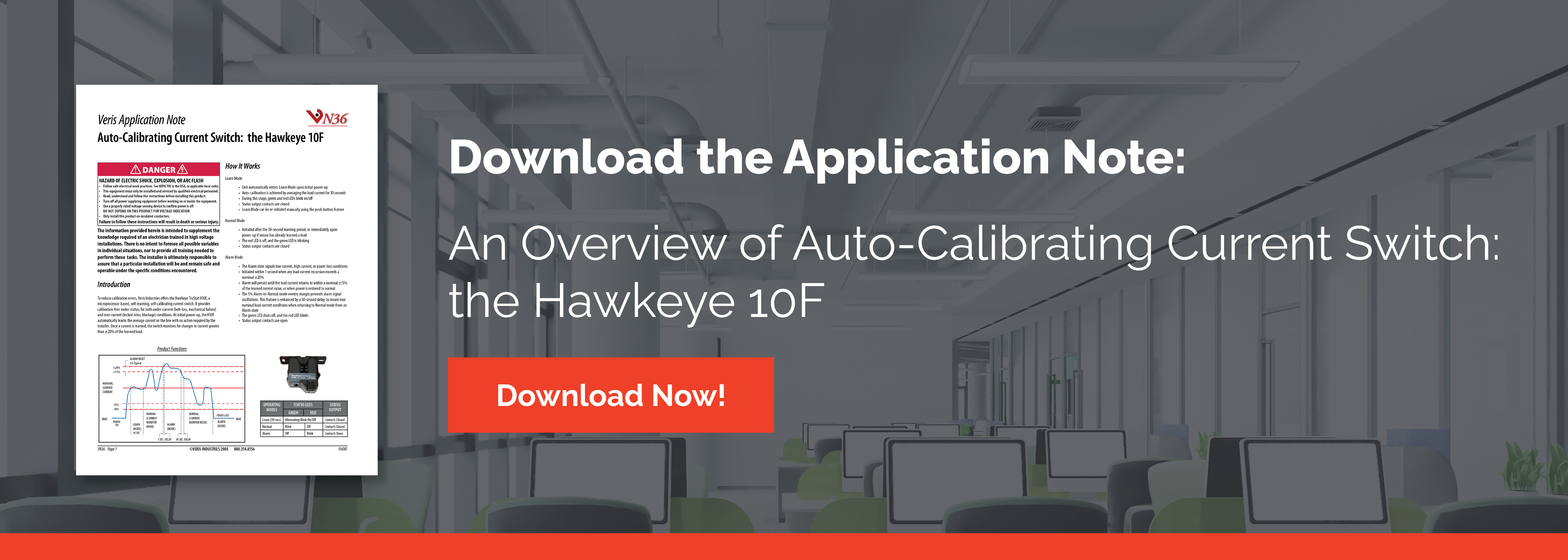Power, Current, & Energy Monitoring With Current Sensors

Current sensors are used to ensure the efficient operation of electrical power and energy systems in a modern building. To decide what sort of sensors or devices you need, you’ve first got to understand your goals.
Are you trying to monitor energy or power? What will the data be used for? Is your goal to streamline your power systems, engage in preventative maintenance, more accurately bill tenants, or something else?
Let’s walk through the terms, applications, and devices you’ll need to know to get the most out of your system and minimize all associated costs.
Table of Contents:
- Are You Trying to Monitor Energy or Power?
- Power vs. Energy Monitoring
- A Monitoring System Can Reduce Energy Consumption
- Power and Energy Monitoring Devices
- Current Monitoring Devices
- How Current Sensors Improve Facility Management
- Power, Energy, & Current Monitoring Sensors From Veris
Are You Trying to Monitor Energy or Power?
Power and energy are related concepts, but they’re not the same. When it comes to current sensors and current monitoring, many people will say “I just want to monitor power,” but what they really mean is “I want to monitor energy usage.”
It’s important to understand the difference:
- Energy is the ability to create change.
- Power is the rate at which energy is used.
Think of energy monitoring as a measure of the actual quantity of electricity you’ve put to use over a period of time. Power is a description of how quickly your equipment or your building is using it and is viewed in a snapshot…just one point in time.
To make an analogy, let’s imagine watering a garden with a hose. The total amount of water that ends up in your garden is the amount of energy you’ve used. The power of the hose is a measure of how fast the water is coming out — how much water you’re pumping out of it at a given moment in time.
Power vs. Energy Monitoring
When you’re using electrical current sensors or submetering the tenants of a multi-unit building, what building owners are often most concerned with is energy — how much electricity the building has used, in total, in a given timeframe (such as one month). However, power monitoring is also a useful tool. Insights into power can confirm equipment status, ensure everything is working correctly, and help you calculate predicted energy usage per month or year.
Why Monitor Power?
Power is an important concept for matching up wires, bus bars, transformers, and equipment so that each piece of equipment is getting enough power (energy over time) to run correctly. It will take a 120-volt source with an electrical current of 5 amps to power a 600-watt motor. (120 Volts X 5 Amps = 600 Watts). The 600 Watts is the power used by that motor.
When you’re monitoring power, you’re looking at a snapshot of how quickly your building or your equipment is using electric energy. This might mean the total power available for use (Apparent Power) or the total Wattage actually put to use at a given point (Real Power). Power usage will fluctuate over time with equipment usage.
Why Monitor Energy?
But how many Watts is that 600 Watt motor using per month? This is measured in kilowatt-hours (kWh), or energy units of 1,000 watts per hour. This total usage of energy is the sort of metric that would be reflected in your electric bill. When you’re monitoring energy, you’re likely measuring the total electricity usage over the course of the month in kilowatt-hours.
A Monitoring System Can Reduce Energy Consumption
When you want to reduce energy consumption starts with tracking where and how your facility consumes energy. In the old days, energy monitoring was often simply a total building metric. More and more data is at our fingertips with energy monitoring modern technologies. It’s now simple to monitor individual circuits so that building owners and facility managers can pinpoint power and energy consumption within the premises.
To do this, you must deploy a power monitoring system or an energy monitoring system (or ideally, both).
What’s a Power Monitoring System?
A network of electrical power monitoring devices can help you to understand and reduce energy consumption by revealing power usage trends and opportunities to change or optimize them. You’ll also be able to get ahead of problems or faulty equipment and wiring that are causing trouble, drawing too much power, or may be in need of maintenance (which saves you on the higher costs of repairs or replacements from breakdowns and outages later on).
What’s an Energy Monitoring System?
Your energy monitoring system is the sum of all the individual sensors and meters that are recording your total energy usage over a given timeframe, often in kilowatt-hours or kWh. You may meter energy usage at the building or branch level, but it’s also useful to see more sophisticated breakouts of departments, rooms, or individual equipment. Today’s energy monitoring systems are more versatile than ever. The best options combine multi-phase measurements with a selection of native communication protocols (SNMP, Modbus, BACnet, etc.) that will make them easy to seamlessly integrate with all existing control systems.
Power and Energy Monitoring Devices
The ideal system will be made up of an integrated network of power and energy monitoring devices. Track electricity usage across each area of your facility or even the individual units that make up your building systems with power and energy monitoring devices such as:
Learn more about these solutions and how they can help optimize your power systems here.
The Importance of Submetering
Commercial building owners with multiple tenants commonly estimate their anticipated energy costs. Those estimated costs help owners decide upon sufficient lease costs per square foot.
But estimating costs can be a problem. Each tenant will have unique energy needs. If you have only a single master electrical meter, you may be able to see what your building is historically using, but not how each tenant is contributing to the overall electrical load. Guesswork also regularly underestimates the true electrical bill, leaving unallocated costs that ultimately lead to higher costs across all tenants — unfairly for some.
Multiphase metering is ideal for commercial submetering in buildings with:
- High energy use tenants
- Tenants with extended operating hours
- Buildings where tenants change frequently
- Apartments, condominiums
- Central heating and cooling plants for common systems
Commercial submetering and multi-tenant metering will allow you to segment energy use in output reports and generate individualized bills that accurately reflect each tenant’s electricity use. This could potentially save thousands of dollars.
Submetering Solutions
Tenant submetering should not require extensive (and expensive) rewiring projects or a new building automation system. There are also cost-effective ways to clearly define and meter multi-phase tenant energy use without having a utility come out and charge you extra for submeter installation.
A wide array of electrical power metering and energy management products are available from Veris that can solve your needs with quick installation and no rewiring. For example, our E71 DIN rail power meter natively supports your existing BACnet/IP, Modbus TCP/IP, or SNMP system and allows for efficient multi-tariff functionality. Just connect your submeter’s outputs to a DDC or other automation system and you’re good to go. Explore more advanced power meters here.
Current Monitoring Devices
Electrical current is measured in amperes (amps or A), and represents the volume of electricity flowing through a conductor. Measuring this current or amperage can be useful for many applications, such as monitoring the functioning status of fans and pumps or keeping track of load trending.
Terms for devices that detect current — a Current Sensor, Switch, or Transducer — are sometimes used interchangeably, but they have subtle differences in meaning.
Current Sensor, Switch, or Transducer?
- Current Sensor: This is the broadest, catch-all term. It essentially means a device that senses electrical current (the flow of electrons, or amperage). There are analog and digital versions.
- Analog Current Sensor: This is like a speedometer for electricity. Analog sensors detect and show an amperage range or volume consumed.
- Digital Current Sensor (AKA Current Switch): A switch detects current and communicates whether it’s running at an amperage set by the user (with an on/off switch). If the amperage detected is out of range, the switch can trigger a warning light, alarm, or send a message to another system. Use current switches to verify the run time of lighting circuits, detect mechanical failures, track VFD output, and more.
- Current Transducer: A transducer is a converter. It reads the raw alternating or direct current and transforms it into a standard electrical signal output that’s appropriate to the software your system uses. Typical outputs might be 4 – 20mA, 0 – 5Vdc, 0 – 10Vdc, 1Vac, or 0.333Vac. Transducers are ideal for tracking load trending, motor control, and fan/pump status.
In some power metering applications, the current flowing through a conductor is too high for direct connection to the meter. In these applications, another device called a current transformer (CT) is placed around the conductor and wired to the meter. The CT reads the current in the conductor and transforms it into a signal that is proportional to the reading. This signal is then sent to the meter. In this way, the CT isolates and protects the meter.
How Current Sensors Improve Facility Management
Energy, power, and current monitoring devices are invaluable tools for optimizing facility management. Devices like an energy consumption meter give you an easy way to monitor, organize, and analyze trends. They’ll also educate you on the forensics behind major fluctuations and adverse events.
With the right meters, switches, transducers, and other devices in place, your facilities team has a clear view of the status of all mechanical equipment. Your power and energy monitoring system is not just for optimizing electricity usage (although it’s great for that). It’s also for helping you to anticipate maintenance issues before they become a problem.
Here are a few ways that current sensors and other energy monitoring devices can help you to improve your facility management:
- Understanding your facility’s peak usage, seasonality, and overall electrical costs
- Streamlining energy consumption with this data on load trends
- Identifying and resolving excess electrical expenses
- Managing HVAC devices like fans, ventilators, motors, pumps, and more
- Predicting imminent failures of electrical equipment (for preemptive maintenance)
- Monitoring and troubleshooting the control wiring in electrical equipment
- Breaking out accurate, individualized bills for multiple tenants
The more closely you monitor your energy, power, and current trends, the easier it will be to realize improvements that reduce your maintenance workload and energy bill. Energy and current monitoring systems combine savings with peace of mind.
Power, Energy, & Current Monitoring Sensors From Veris
Our comprehensive selection of current, power, and energy monitoring devices has the solution you need for your existing building management system and your budget. Browse your options across each device category below:
Have questions? Don’t hesitate to reach out and connect with a Veris sensor expert in a virtual meeting at your convenience. We’ll be happy to help you identify the right product for your application and to provide the answers you need to improve facility management while reducing costs.





